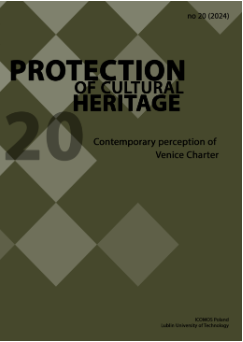Karta Wenecka w dobie zmian klimatycznych
Tino Mager
tino.mager@gmail.comUniversity of Groningen (Holandia)
https://orcid.org/0000-0002-3636-221X
Abstrakt
Niniejszy artykuł jest refleksją na temat Karty Weneckiej jako produktu lat 60. XX wieku i umieszcza ją w kontekście dziedzictwa budowlanego i dyskursu związanego z nim w tamtym czasie. Zawiera refleksje na temat ciągłej ważności Karty, a w szczególności na temat jej znaczenia w czasach zmieniających się warunków klimatycznych. Artykuł ma na celu ponowną kontekstualizację Karty w XXI wieku i zawiera sugestie dotyczące zapewnienia jej ciągłej aktualności. Podczas gdy Karta Wenecka zdefiniowała główne zasady ochrony dziedzictwa w drugiej połowie XX wieku, pozostaje niejasne, czy zasady te, choć uznane i uznane, mogą zostać utrzymane w świecie o bardzo różnych warunkach dla dziedzictwa budowlanego.
Słowa kluczowe:
zmiana klimatu, autentyczność, Karta Wenecka, zrównoważony rozwójBibliografia
DeSilvey, C. (2017). Curated Decay: Heritage beyond Saving. University of Minnesota Press.
Google Scholar
Direzione generale per le antichità e belle arti. (1964). 2a Mostra internazionale del restauro monumentale, Venezia, Palazzo Grassi, 25 maggio–25 giugno 1964, in occasione del II. Congresso internazionale degli architetti e tecnici dei monumenti. Palazzo Grassi.
Google Scholar
ECMWF (European Centre for Medium-Range Weather Forecasts). (2024). Copernicus: 2023 is the hottest year on record, with global temperatures close to the 1.5°C limit. Press Release, 9 January.
Google Scholar
European Commission, Directorate-General for Education, Youth, Sport and Culture. (2022). Strengthening cultural heritage resilience for climate change – Where the European Green Deal meets cultural heritage. Publications Office of the European Union.
Google Scholar
Gazzola, P., & Roberto P. (1971). Proposte per una Carta internazionale del Restauro. In ICOMOS. Il monumento per l’uomo: atti del II Congresso Internazionale del Restauro Venezia, 25–31 maggio 1964 = Le monument pour l’homme: actes du II Congrès International de la Restauration = The monument for the man: records of the II International Congress of Restoration (pp. 14–19). Marsilio.
Google Scholar
Holtorf, C. (2015). Averting loss aversion in cultural heritage. International Journal of Heritage Studies, 21(4), 405–421. https://doi.org/10.1080/13527258.2014.938766
Google Scholar
ICOMOS. (1971). Il monumento per l’uomo: atti del II Congresso Internazionale del Restauro Venezia, 25–31 maggio 1964 = Le monument pour l’homme: actes du II Congrès International de la Restauration = The monument for the man: records of the II International Congress of Restoration. Marsilio.
Google Scholar
ICOMOS. (2014). ICOMOS debate on permissibility and standards for reconstructions of monuments and sites. http://www.icomos.org/en/what-we-do/disseminating-knowledge/ newsletters/704-icomos-debate-on-permissibility-and-standards-for-reconstructions-of- monuments-and-sites-online-survey.
Google Scholar
ICOMOS. (2024). Anpassungsstrategien für Baudenkmale im Klimawandel. ICOMOS.
Google Scholar
International Committee of the Red Cross (2021). The Climate and Environment Charter for Humanitarian Organizations. URL: https://www.icrc.org/en/document/red-cross-red-crescent-humanitarian-sector-joins-forces-tackle-existential-threat-climate
Google Scholar
Langenberg, S. (Ed.) (2018). Reparatur. Anstiftung zum Denken und Machen. Hatje Cantz.
Google Scholar
Lipp, W. (1994). Vom modernen zum postmodernen Denkmalkultus? Aspekte zur Reparaturgesellschaft. In: Lipp, W., Petzet, M. (Eds.) Vom modernen zum postmodernen Denkmalkultus? Denkmalpflege am Ende des 20. Jahrhunderts. Bayerisches Landesamt für Denkmalpflege.
Google Scholar
Mach, K.J. & Siders, A.R. (2021). Reframing strategic, managed retreat for transformative climate adaptation. Science, 372,1294–1299. DOI:10.1126/science.abh1894
Google Scholar
Mager, T. (2016). Schillernde Unschärfe. Der Begriff der Authentizität im architektonischen Erbe. DeGruyter.
Google Scholar
Meurs, P. (2007). A charter for each intervention: from generic to specific guidelines. City & Time, 3(3), 53–60.
Google Scholar
Molajoli, B. (1964). In: Direzione generale per le antichità e belle arti. (1964). 2a Mostra internazionale del restauro monumentale, Venezia, Palazzo Grassi, 25 maggio–25 giugno 1964, in occasione del II. Congresso internazionale degli architetti e tecnici dei monumenti. (p. VI) Palazzo Grassi.
Google Scholar
Normand, C. (Ed.). (1889). Congrès international pour la protection des œuvres d’art et des monuments, tenu à Paris du 24 au 29 juin 1889. Imprimerie Nationale.
Google Scholar
Normand, C. (1889b). Premières idées sur l’organiation de la Croix Rouge pour la protection des monuments en temps de guerre. L’Ami des monuments, 3, 272–277.
Google Scholar
Priebe, J., Reimerson, E., Hallberg-Sramek, I. et al. (2022). Transformative change in context—stakeholders’ understandings of leverage at the forest–climate nexus. Sustain Sci, 17, 1921–1938. https://doi.org/10.1007/s11625-022-01090-6
Google Scholar
Seck, A. (2021). Klimaopfer Denkmal. monumente online. 6, 2021, https://www.monumente-online.de/de/ausgaben/2021/3/Klimaopfer-Denkmal.php (access: 18 March 2024).
Google Scholar
Weststeijn, T. (2023). De Toekomst van het verleden. Erfgoed en Klimaat. Prometheus.
Google Scholar
Zachwatowicz, Jan. (1971). Nouveaux Aspects de la Théorie de Conservation des Monuments historiques. In ICOMOS. Il monumento per l’uomo: atti del II Congresso Internazionale del Restauro Venezia, 25–31 maggio 1964 = Le monument pour l’homme: actes du II Congrès International de la Restauration = The monument for the man: records of the II International Congress of Restoration (pp. 47–53). Marsilio.
Google Scholar
Autorzy
Tino Magertino.mager@gmail.com
University of Groningen Holandia
https://orcid.org/0000-0002-3636-221X
Statystyki
Abstract views: 67PDF downloads: 41









